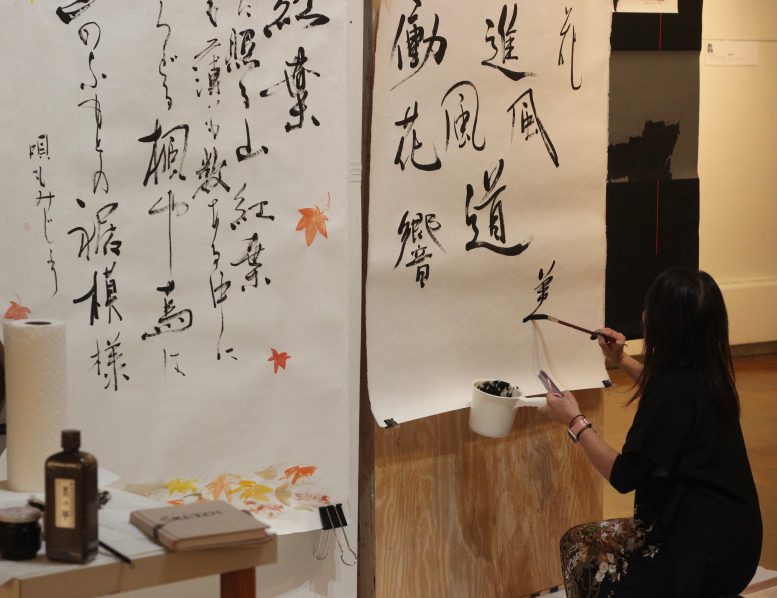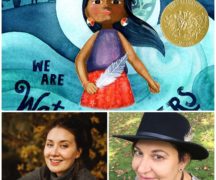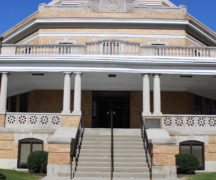By DAVID DUPONT
BG Independent News
Kyoko Fujii started studying calligraphy when she was 6 growing up in Hiroshima, Japan.
It was a popular after school activity, she said. Most students after a few years move onto other hobbies.

Kyoko Fujii copies the lyrics of a children’s song. Detail of finished scroll below.
Fujii however continued to study. For her doing calligraphy was like eating or breathing. She took weekly lessons for many years with a master calligrapher. Despite her abiding interest, she didn’t reflect on her art much.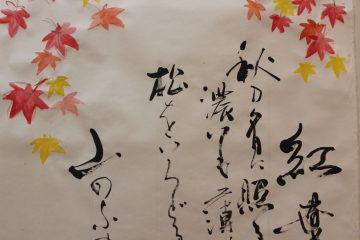
It was only when she was 24 and her employer, a securities and banking firm, sent her abroad to the southern United States that she realized that what she did was something special, something beautiful, a way to reach out and connect with people.
Now a master instructor herself, Fujii visited Bowling Green State University on Saturday to teach the art as part of the opening of an exhibit of calligraphy scrolls given to the Asian Studies Program by the Japanese counsel general in Detroit.
“Shodo Way of Writing: Calligraphy Scrolls from the BGSU Asian Studies Collection” will be on display in the Willard Wankelman Gallery in the Fine Arts Center through Nov. 18.
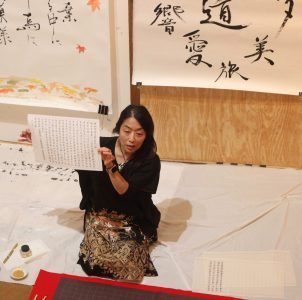
Artist shows a copy of the prayer she will copy out.
Fujii, who now lives in Novi, Michigan, said it was an honor to demonstrate her art amidst so many fine examples of both traditional and contemporary calligraphy.
She has mastered both kohitsu (pen writing) and mohitsu (brush writing) techniques,and demonstrated both.
She started by writing out the lyrics of a popular children’s song about maple trees in fall. She had painted yellow and red maple leaves in the margins of her paper beforehand. Then as the song played on her iPod, the Japanese characters appeared.
More than a simple letter, each character is a combination of images that together create the meaning of the word. And the character is executed with a flourish that’s a visual representation of the meaning.
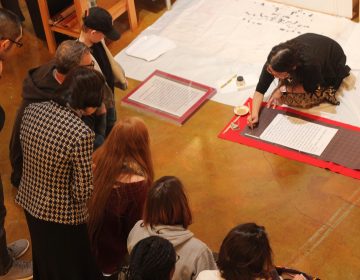
Visitors watch as artist copies in pen a prayer.
Fujii said her American husband always wants to know what the words and meanings are of her paintings, she said.
This came through in the second part of Fujii’s presentation. Taking individual words, she painted them, and explained how they are constructed. The word “work” included symbols for human, heart, and power. When writing the word for wind or breeze, the way the character is drawn shows the kind of wind it is.

Kyoko Fujii after finishing her work copying a Buddhist prayer.
She concluded her demonstration by switching to a gold pen to write out a Buddhist prayer. The entire prayer would take a day to copy, so she did the beginning lines. When asked, she chanted prayer in Japanese.
Raymond Craig, dean of the College of Arts and Science, said this is an important part of what the college does. More than exposing students to other cultures, it gives them first-hand knowledge and hands-on experience in elements of that culture.

